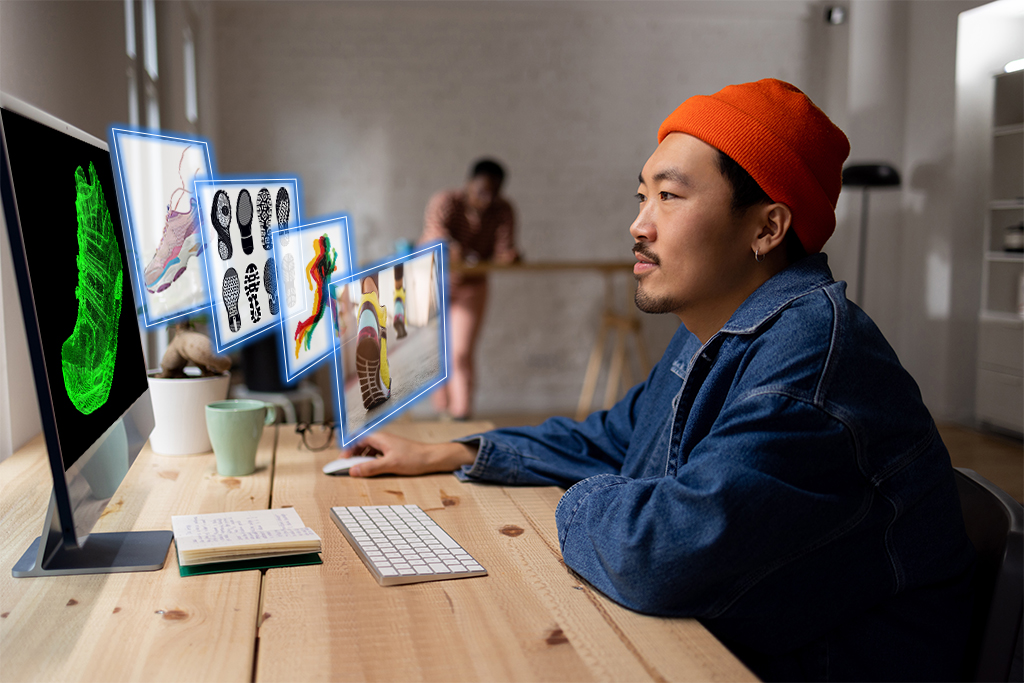Released in The Interline’s DPC Report 2023, this executive interview is one of a sixteen-part series that sees The Interline quiz executives from major DPC companies on the evolution of 3D and digital product creation tools and workflows, and ask their opinions on what the future holds for the the extended possibilities of digital assets.
For more on digital product creation in fashion, download the full DPC Report 2023 completely free of charge and ungated.
Key Takeaways:
- The goals of 3D and DPC align neatly with fashion’s top objectives – consumer centricity, streamlining operations, improving margins and reducing waste – making investment in digital product creation a strategic priority.
- Connectivity, visibility, and the ability to visualise and utilise data across different disciplines is key to realising a return on investment in DPC tools, talent, and resources.
- As a central focus of the DPC technology ecosystem, PLM can be power collaborative development of 3D assets, and support their deployment everywhere from design to eCommerce and marketing.
What do you believe are the greatest opportunities that are realistically achievable, in 2024, through investment in DPC talent and tools?
Retailers, brands and manufacturers of both soft and hard goods are facing increasing market challenges, and DPC opportunities must align with what consumer goods companies need to do to overcome those challenges. Economic conditions, from inflation to interest rates, are squeezing margins and increasing competition for shrinking consumer wallets. Add to this fickle consumer behavior, geopolitical unrest and disruptions due to weather and natural disasters, and you have a daunting picture.
The greatest opportunities for investment in DPC are the same as the top-of-mind concerns for brands. DPC has a role to play in:
- Getting closer to consumers, which involves delivering consumer-centric products and assortments that will reduce inventory and improve sales and margins.
- Streamlining operations by improving internal and external collaboration to be more efficient, speed time to market, enhance sustainability and ensure compliance with regulations.
- Improving margins through interventions at every point in the product lifecycle, from more cost-effective collaboration with suppliers, to reducing waste, to cutting out resource-heavy tasks.
AI and machine learning are fantastic tools that are already improving overall business performance. AI/ML will also be the key drivers for enhancing enterprise tools like DPC solutions, especially in terms of realistic texturing and material simulation. Closer integration between 3D design and product development tools, PLM solutions and 3D material scanners will speed time to market and help businesses deliver products consumers want.
The major opportunities in 2023/24 are in investing in technology that can fully bring the promises of DPC to fruition. We’ve spoken about benefits such as reduced sampling and faster time to market for a long time – and these benefits have been delivered to a degree. However, fast-moving developments in DPC, particularly in 3D materials, will make it possible to develop those benefits further.
There are exciting possibilities on the design concept side. Interdisciplinary talent will merge artistic creativity with technical expertise using tools like text to 3D, for instance. AI-rendered product imagery will bridge the gap for slower adopters of DPC, bringing them closer to a correct visual representation of the product. Developments in virtual try-ons and how close we can get to a realistic representation of fit will be very important in terms of returns mitigation and e-commerce in general.
A lot of 3D initiatives have, for a long time, focused on the vision for virtual sampling – cutting out one or more rounds of physical samples by replacing that iterative process with decision-making based on digital samples instead. How far have we come to actually realising that vision today, and what have been the key unlocks along the way, based on your experience with Centric’s customers and the way they use your solutions?
When considering investment in DPC, brands first need to take note that DPC is resource-hungry and generates large amounts of data. Powerful hardware, efficient digital asset management and cloud hosting is critical for scalable 3D design. Finding the right talent can be a challenge as well.

Several customers that we work with have successfully invested in and created a DPC workflow and are already realizing that vision, with some saving weeks worth of time in creating samples. While physical samples certainly still have a place for most customers, particularly towards the end of the sampling process, digital sampling is streamlining and shortening the earlier phases of sampling. Our customers report that digital samples are enabling them to cut sampling rounds, do fewer revisions, achieve shorter lead times and streamline collaboration with factory partners.
Customers are using DPC to overlay new materials and colorization on carryover styles to save time and resources. This makes it easier to shorten timelines with factory partners who already have access to the original product data and 3D files. Some have taken a hybrid approach to reduce sales samples, building styles from the ground up with 3D, generating virtual samples, then perhaps carrying only one through to physical sampling and commercialization while using 3D to represent alternative colorways and materials to buyers or even consumers.
Beyond sampling, technology has a major role to play in enabling brands to create products with targets in mind – whether that means designing for environmental impact, or designing to cost. But that’s something that hinges on close integration between 3D / DPC tools and the environments where critical product data resides and where creative and commercial choices are made. How do you see Centric’s solutions supporting that drive to empower designers to support strategic objectives?
Designers can only support strategic objectives if they have access to information about those goals and can see exactly how their design choices impact business targets. We’ve always developed solutions with connectedness and visibility in mind. Design and product development teams working with Centric PLMTM can sandbox ideas and run detailed what-if scenarios to see exactly how design and material choices affect strategic objectives, pulling in real-time data from multiple enterprise systems to assess the effect on costs, sustainability goals and more. Visualization of data is really important for teams that work in a visual medium, so these teams can also use Centric Visual BoardsTM to represent data and make collaborative decisions.
We’ve worked in close collaboration with customers to integrate the 3D / DPC tools that they actually use every day with Centric PLM, including popular software such as Browzwear, CLO, Rhino, Optitex, SOLIDWORKS, Vizoo and swatchbook. By doing this, Centric PLM isn’t just the source of critical product data that designers bring from outside the system – it becomes the hub where 3D design can happen and design decisions are made, informed by that data. It is the one single source of truth that keeps all teams on the same page so that they can ensure business objectives are met.
Thinking further than design and development, one of the major themes of this report is the huge array of different use cases that exist for digital assets today. From downstream eCommerce to internal sales and marketing, how is Centric helping to deliver on that broader ambition for what’s possible with digital representations of physical products?
Democratizing the utility of 3D is a key focus in our digital-first strategy. 3D is a big investment for companies, and it makes sense to get the broadest return possible by facilitating the use of digital assets across the organization. Our customers use digital assets for a wide variety of applications outside of product development and sampling, including collaboration with suppliers, buying sessions with wholesalers and store managers, e-commerce, marketing and brand storytelling.
E-commerce is a particularly valuable application of 3D, enabling consumers to view and rotate realistic product imagery. Digital assets are even being tested in virtual try-on apps that project an image of clothing or footwear onto your body in realistic space and at scale. Photogrammetry, which takes hundreds of photos around a product to generate a 3D model of that product, is also coming into its own as a foundation for creating online stores and virtual showrooms for internal buying.

And naturally, 3D technology offers a range of opportunities when it comes to personalization, transforming the way products are designed, manufactured, and experienced by consumers.
All of this is only possible if digital assets can be easily shared and accessed across different enterprise systems and different teams, rather than being confined to the 3D design team.
Whether we’re thinking about technology integration, file interoperability, or cultural change, there’s a lot to consider for any brand, retailer, or supply chain partner who’s looking to make 3D a deeper part of the product development process. What are the most common challenges, and what guidance and best practices have you found to help ease that transition?
As stated earlier, the investment needed in hardware and talent is a challenge.
3D requires a very specific skillset that can be hard for retailers and brands to find and afford.
Another challenge is the closed loop information strategy employed by some 3D vendors that can create friction during the development process. 3D requires material data and pattern-making skills that are trapped in the supply chain. The suppliers own the BOM and materials details. There isn’t an easy answer here, but perhaps we’ll see a shift towards in-house production of 3D assets.
Generative AI is set to disrupt the use of 3D for line visualization. Technologies similar to Midjourney are already being deployed by brands to replace 3D creation with prompt engineering. However, there is a steep technology ramp up to train private data sets using public tools.
Change management is one of the biggest challenges, of course, and any time you have significant change, there will be pushback. Proper training and investment in tools that genuinely make a difference to the everyday work lives of teams will go a long way to persuade people of the advantages of DPC. Without adequate hardware, teams will experience frustration dealing with huge, heavy 3D files. The reality is that some of the technology is still halfway there, and overcoming resistance will take time, investment and belief. Pilot projects and a phased implementation strategy that aligns with the company’s needs and objectives are preferable to diving in head first.
How would you describe the ideal 3D / DPC pipeline – category-specific or generalised – and what barriers are currently preventing it from being built and widely adopted? What pieces still need to be put in place for fashion to stand the best chance of achieving what you define as the full-scale vision for DPC?
The ideal DPC pipeline is agile, scalable and suitable for specific design and development sprints. It’s also a vision that supports business objectives and is therefore connected to the rest of the business. We see PLM as the central focus for collaborative development of 3D assets, and their deployment throughout the business ecosystem for other purposes such as e-commerce and marketing.
New DPC technology has to use standardized formats, make 3D easier to author, make material information easier to capture, and make 3D light enough to be used across teams. Decimation tools can greatly reduce file sizes, but brands need to be certain that the associated loss of fidelity won’t have a major impact on decision-making.
Brands need to have a clear vision that justifies investment, and a detailed roadmap for adopting DPC. They also need to ensure that their DPC vision is connected to the rest of the business through foundational enterprise systems like PLM and Planning in order to deliver the best results. For fashion to fully take advantage of the benefits of DPC, the whole ecosystem needs to continue to evolve in a way that delivers real value to adopters of DPC technology.

